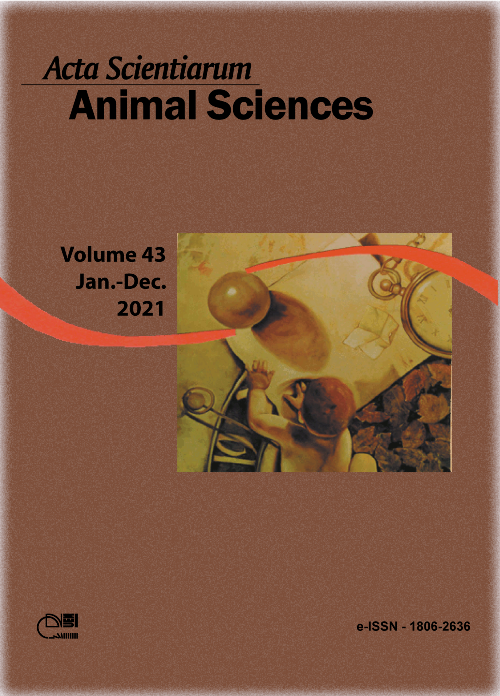Effect of crude propolis on the performance and feed digestibility of new zealand white rabbits
Abstract
The objective of this study was to evaluate the performance and digestibility of diets containing different levels of crude propolis for growing rabbits. Forty-eight New Zealand White rabbits, 43 days old, of both genders, were used, distributed in a completely randomized design. There were four diets with different inclusion levels of crude propolis (0.0; 0.5; 1.0 and 1.5%). There was no statistical difference for performance regarding the inclusion levels of crude propolis (p = 0.85), as well as for the variables dry matter consumption, neutral detergent fiber and acid detergent fiber (p ≥ 0.07). Crude protein consumption showed a statistical difference in relation to gender (p = 0.04): males showed higher consumption. However, final weight, total weight gain, daily weight gain and feed efficiency were not influenced by the addition of crude propolis (p ≥ 0.37). Dry matter digestibility, crude protein, neutral detergent fiber and acid detergent fiber were not influenced by the inclusion levels of crude propolis in the diets (p ≥ 0.12). This study indicates that the inclusion of raw propolis up to 1.5% in the diets does not affect the performance parameters of rabbits.
Downloads
References
References
Bellaver, C., Monteiro, G., & Zanatto, D. (2015). Alimentação por sexo separado. Recuperado de http://www.agencia.cnptia.embrapa.br/gestor/suinos/arvore/CONTAG01_175_1012200293749.html
Blas, J. C., & Mateos, G. G. (2010). Feed formulation. In C. Blas & J. Wiseman (Eds.), The nutrition of the rabbit (2nd ed., p. 222-232). Cambridge, GB: CAB International.
Brasil. (2001). Instrução Normativa nº 3 – Anexo VI – Regulamento técnico para fixação de identidade e qualidade de própolis. Brasília, DF: Diário Oficial.
Buffington, C. (1981). Black globe humidity index (BGHI) as comfort equation for dairy cows. Transacofthe ASAE, 24, 711-714. Retrieved on March 7, 2018 from https://bitlybr.com/fr6C
Coelho, M., Silva, J., & Oliveira, E. (2010). Própolis e sua utilização em animais de produção. Archivos de Zootecnia, 59,95-115. doi: 10.21071/az.v59i232.4909
Coloni, R. (2007). Extrato etanólico de própolis sobre o ganho de peso, parâmetros de carcaça e pH cecal de coelhos em crescimento. Biotemas, 2(20), 59-64. doi: 10.5007/%25x
Frota, M. C. (2015). Como fazer criação de coelhos. Recuperado de https://bitlybr.com/KDQoRX1U
Garcia, R. C. (2004). Efeito do extrato alcoólico de própolis sobre o perfil bioquímico e o desempenho de coelhas jovens. Acta Scientiarum. Animal Sciences, 2(1), 54-64.
Klinger, A., Toledo, G., & Eggersi, D. (2014). Casca de soja em dietas para coelhos em crescimento. Ciência Rural, 163-169. doi: 10.4025/actascianimsci.v26i1.1950
Lui, J. F., Oliveira, M. C., Caires, D. R., & Cancherini, L. C. (2005). Desempenho, rendimento de carcaça e pH cecal de coelhos em crescimento alimentados com dietas contento níveis de probióticos. Ciência Animal Brasileira, 6(2), 87-93.
Machado, L. (2012). Avaliação das deitas simplificadas e semi simplificadas, com base na mistura de forragens, com e sem enzimas, para coelhos em crescimento. Ciência Animal Brasileira, 13(3), 330-337. doi: 10.5216/cab.v13i3.17565
Mello, H. V., & Silva, J. F. (2012). Criação de Coelhos (2. ed.). Viçosa, MG: Aprenda Fácil.
Nesi, C. N., & Demeda, L. (2015). Ganho de peso e conversão alimentar de coelhos em razão da composição da ração. Unoesc & Ciência - Acet, 1(6), 61-64.
Prado, O. P. P. (2011). Adição de própolis ou monesina sódica sobre digestibilidade in vitro da matéria seca. Revista Brasileira de Saúde e Produção Animal, 11(4), 1023. doi: 10.1590/S1516-35982010000900026
Retore, M., Scapinello, C., & Moreira, I. (2012). Glicerina semipurificada vegetal e mista na alimentação de coelhos em crescimento. Arquivo Brasileiro de Medicina Veterinária e Zootecnia, 64(6), 1723-1731.
Sakomura, N. K., Silva, J. H. V., & Costa, F. G. P. (2014). Nutrição de não ruminantes. Jaboticabal, SP: Funep.
Scapinello, C., Antunes, E. B., & Furnan, A. C. (2003). Fenos de leucena (Leucaena leucocephala e Leucaena leucocephala cv. Cunningham) para coelhos em crescimento: digestibilidade e desempenho. Acta Scientiarum. Animal Sciences, 25(2), 301-306. doi: 10.4025/actascianimsci.v25i2.2006
Silva, D. J. (2012). Análise de alimentos: métodos químicos e biológicos. Viçosa, MG: UFV.
Statistical Analysis System [SAS]. (2016). Statistical Analysis System user’s guide, version 9.2. Cary, NC: SAS Institute Inc.
Thom, E. C. (1958). Cooling degrees - days air conditioning, heating, and ventilating. Transactions of the ASAE, 55(7), 65-72.
Van Soest, P. J. (1994). Carbohydrates. In Nutritional ecology of the ruminant (p. 156-176). Ithaca, NY: Cornell University Press.
Zanato, J. A. (2008). Digestibilidade de dietas contendo antibiótico, probiótico e prebiótico para coelhos em crescimento. Biotemas, 4(21), 131-13. doi: 10.5007/2175-7925.2008v21n4p131
DECLARATION OF ORIGINALITY AND COPYRIGHTS
- I Declare that current article is original and has not been submitted for publication, in part or in whole, to any other national or international journal.
The copyrights belong exclusively to the authors. Published content is licensed under Creative Commons Attribution 4.0 (CC BY 4.0) guidelines, which allows sharing (copy and distribution of the material in any medium or format) and adaptation (remix, transform, and build upon the material) for any purpose, even commercially, under the terms of attribution.
Read this link for further information on how to use CC BY 4.0 properly.








































